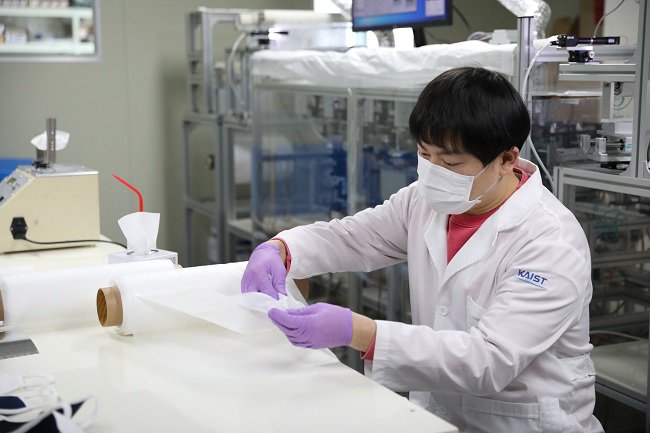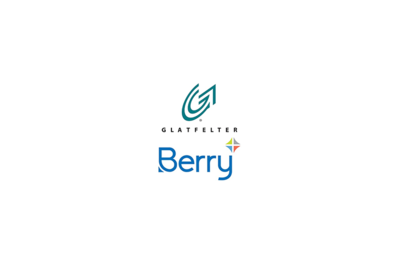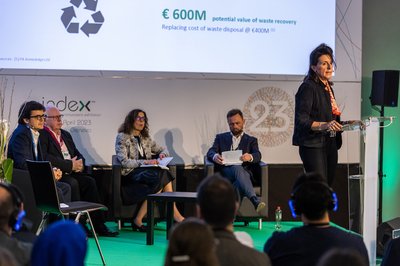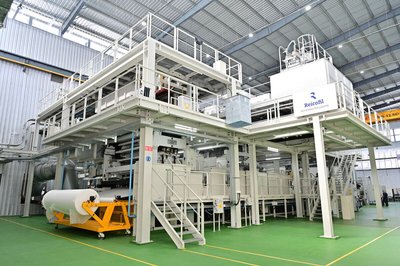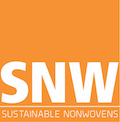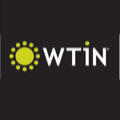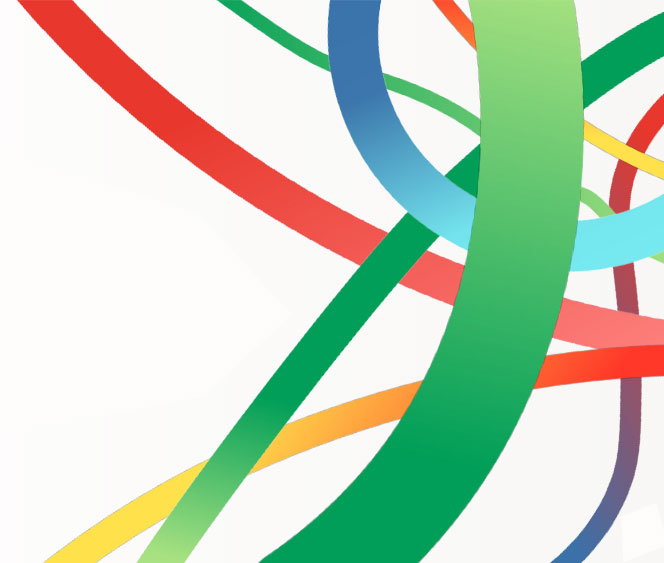
As the wearing of nonwoven facemasks becomes ubiquitous, material scientists around the world have been exploring methods of further improving their effectiveness, expanding their functionality and trying to address their disposable nature.
Swiss research institutes Empa and EPFL, for example, have developed fully-transparent surgical facemasks based on biomass-based electrospun nanofibres.
Branded HelloMasks, they promise to make contact between caregivers and patients much less impersonal and at present consist of 99% biomass derivative, with the aim of achieving 100% in the near future.
A new start-up company formed to scale up the production process, HMCare, has already raised a million Swiss francs in seed-funding for the venture.
Fluorescent signal
Researchers at MIT have meanwhile integrated sensors into facemasks that produce a fluorescent signal if coronavirus is detected when the wearer breathes, coughs or sneezes. This development promises to address the flaws that have been associated with other screening methods such as temperature checks.
The MIT sensors consist of genetic material — DNA and RNA — that binds to a virus. The material is freeze-dried onto the fabric using a machine called a lyophilizer, which sucks moisture out of the genetic material without killing it. It can remain stable at room temperature for several months, giving the masks a relatively long shelf-life.
The sensors need two things to be activated – moisture given off through respiratory particles like mucus or saliva and the genetic sequence of the virus which is currently the focus of intense research.
Electroceutical protection
A new electroceutical nonwoven developed at Indiana University and currently awaiting FDA approval for use in facemasks has the ability to effectively eliminate coronavirus.
The term ‘electroceutical’ refers to a matrix of embedded microcell batteries that creates an electric field and wirelessly generates a low level of electricity in the presence of moisture.
It is well known that viruses can be electrically charged, while coronaviruses rely on electrostatic interactions to be able to attach to their host and assemble themselves into an infective form. Their structure must remain stable in order to spread infection. The researchers have exploited these electrokinetic characteristics to try to dismantle the infectivity of the virus via fabrics.
The low-level electric field-generating fabric is already in commercial use as a broad-spectrum antimicrobial wound care dressing called V.Dox Technology – a proprietary dot-matrix pattern of embedded microcell batteries that creates an electric field and wirelessly generates a low level of electricity when moist.
Sanitiser
As a partner with Czech-based nanofibre technology specialist and INDEX™20 exhibitor Elmarco, Hybrisan, an antimicrobial specialist based in Wales, has ingeniously developed a method of electrospinning sanitiser liquid into nanofibre nonwovens for facemasks.
The company has received £500,000 in funding and is investing in a new electrospinning machine to scale up the production of the new material.
Graphene
A graphene coating could make facemasks easier to sterilize and re-use, according to a team of researchers at The Hong Kong Polytechnic University (PolyU).
The team have developed a laser manufacturing process that deposits a few layers of the carbon sheet onto commercially-available facemasks. The coating makes the masks superhydrophobic, which reduces the chances of infectious drops adhering to them, while graphene’s strong light-absorption properties make it possible to sterilize them with exposure to sunlight.
This is possible because graphene absorbs over 95% of light across the solar spectrum from 300 to 2500nm, so the coated masks quickly increase in temperature, reaching 70°C after 40 seconds of solar illumination and over 80°C after 100 seconds. This is high enough to inactivate most types of viruses, meaning that the mask can then be reused or, if damaged, safely recycled.
Aligned nanofibres
In a parallel development, a research team at the Korea Advanced Institute of Science and Technology (KAIST) has developed a nanofibre facemask that maintains excellent filtering efficiency even after hand washing.
It is based on proprietary technology that aligns nanofibres with a diameter of 100-500nm in orthogonal or unidirectional directions.
The facemask will maintain its robustness and filtering function even after being washed more than 20 times and is now awaiting final approval from the country’s Ministry of Food and Drug Safety to be brought to market.
An insulation block electrospinning process is used to manufacture orthogonal nanofibres by controlling their alignment. This structure minimises delivery of the pressure towards the air filter and maximise the filtration efficiency.
Existing masks also fail to maintain their air filtering function because their electrostatic function disappears when exposed to water and as a consequence, the filtering efficiency is reduced significantly, making it almost impossible to reuse them.
The new nanofibre mask has proven to be water resistant, with more than 94% filtering efficiency in 20 repeated bactericidal tests with ethanol. The nanofibre mask also showed no deformation in its nano-membrane structure, despite the 20 hand washes. In particular, it was confirmed that there were no deformations in the membrane, even after soaking in ethanol more than three hours.
No longer invisible
During an era in which President Macron has toured a facemask converting plant, Donald Trump has fired off tweets about INDEX™20 exhibitors and government departments around the world have been obliged to discover the difference between meltblown and spunbond, nonwovens can no longer quite be considered “the invisible industry”.
The expanded investigations by new researchers around the world into the applications for nonwovens and their performance properties can only strengthen the industry’s future.
While Covid-19 has put back the INDEX™show in Geneva by a full 18 months, there is little doubt it has been invigorated by this global scrutiny and the realisation of the importance of protective nonwovens.


